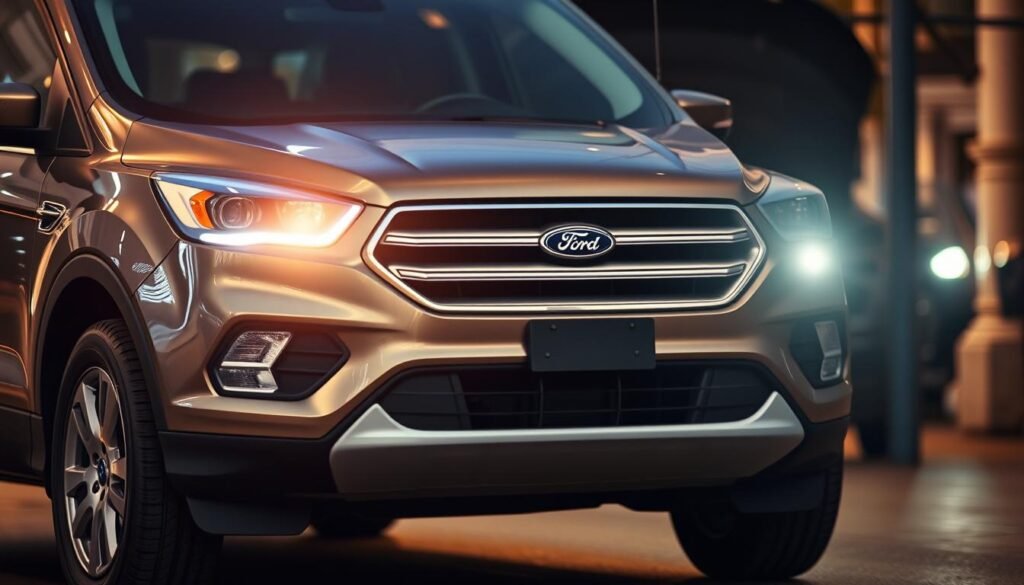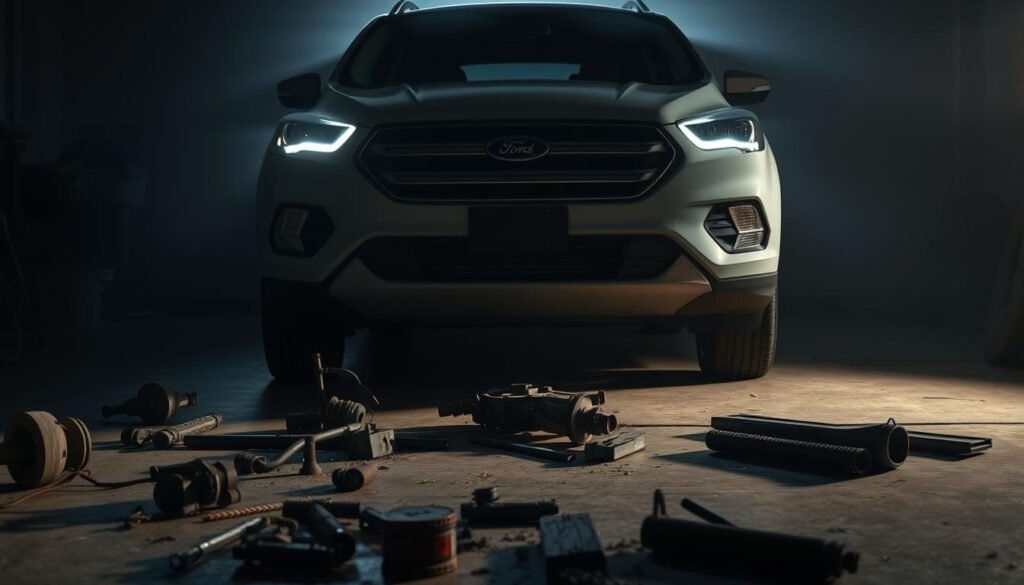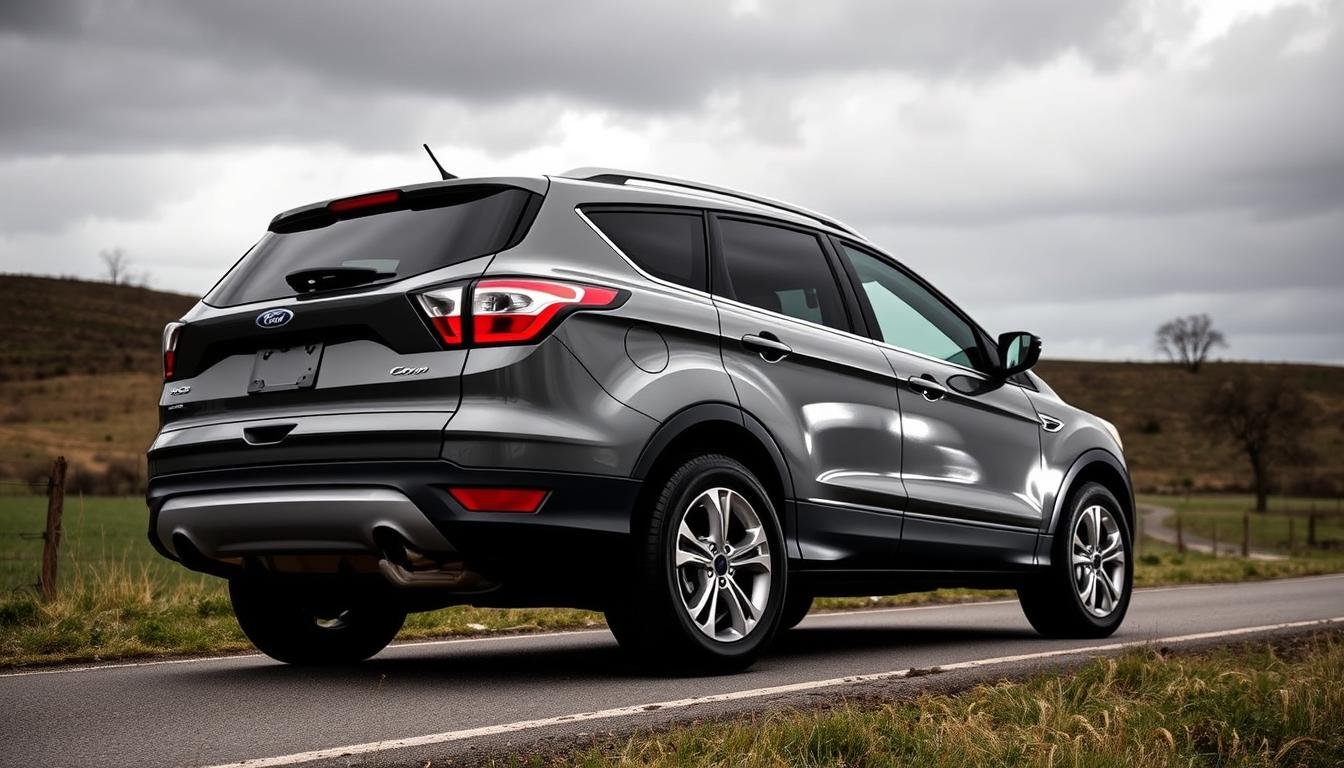Ford Escape Years To Avoid – Buyer’s 7 Guide
Wondering which Ford Escape years to avoid? The Ford Escape, a loved compact SUV since 2000, has some years with big issues.
This guide aims to help you choose wisely, mixing good value with reliability. Knowing which Ford Escape years to skip can make your choice easier.
We’ll highlight which models have the most problems. This will help you avoid stress and pick a car that’s reliable. Read on to find out vital tips for picking a used Ford Escape.
We’ll discuss everything from transmission issues to engine recalls. This guide aims to keep your car running smoothly for a long time.
Introduction To The Ford Escape
The Ford Escape has made quite a name for itself in the car world. It’s known for being flexible and powerful.
It’s a compact SUV that offers lots of room and easy driving, like a sedan. Many people have come to love the ford escape for these reasons.
The Escape has changed a lot over time, getting new looks and better tech. For those looking to buy a used ford escape, it’s key to know about these changes.
Each version has its own special features, making some models better picks than others.
This guide lays the groundwork for understanding each Ford Escape model. It helps future owners figure out which model could give them the best experience.
What is Ford Escape Generations?
The Ford Escape has evolved a lot since it first came out, divided into four major generations.
Each one shows progress in design, tech, and how well it performs, making the Escape’s history quite interesting.
The journey began in 2001 and went on until 2007 with its first generation. This compact SUV caught the eye of many.
But, it wasn’t perfect. Some owners had issues with the transmission early on, which became a noteworthy topic among Escape enthusiasts.
Next came the second generation from 2008 to 2012. Ford made the Escape look and work better during these years.
However, it wasn’t all smooth sailing. Drivers looking for a dependable vehicle were sometimes put off by powertrain troubles.
The third generation spanned from 2013 to 2019. It brought a fresh face and feel to the Escape.
While aiming for a contemporary look, it faced some reliability issues. Shoppers should keep this in mind when digging into Escape’s past.
Now, we’re in the era of the fourth generation, starting in 2020. It’s known for top-notch safety and the latest tech.
This generation signals a significant shift in the Escape’s journey, mixing practical needs with the newest innovations.

| Generation | Years | Key Features | Common Issues |
|---|---|---|---|
| First Generation | 2001-2007 | Compact SUV design, user-friendly interior | Early transmission issues |
| Second Generation | 2008-2012 | Refined design, improved engine options | Powertrain problems |
| Third Generation | 2013-2019 | Significant redesign, tech upgrades | Reliability concerns |
| Fourth Generation | 2020-Present | Advanced safety features, tech integration | Minimal issues reported |
Key Issues That Affected The Ford Escape Models
The Ford Escape has faced a lot of issues over the years, affecting how much people like them.
You might come across common problems like bad transmissions, engine issues, and electrical problems.
Especially the ones made between 2001 to 2004, which had major transmission troubles, making repairs very expensive for owners.
As the years went by, the 2013 and 2014 models started having their own issues. These included the engine stopping suddenly or getting too hot.
These problems made owners frustrated because they relied on their car every day. Plus, there were lots of complaints about the electrical system not working right, which made taking care of the car even harder.

If you’re thinking about buying a used Ford Escape, knowing about these issues is really important.
Knowing which years had the most problems can help you avoid buying a car that might give you trouble.
| Model Year | Common Issues | Impact on Reliability |
|---|---|---|
| 2001-2004 | Transmission failures | High repair costs |
| 2013-2014 | Engine stalling and overheating | Loss of trust in reliability |
| Various | Electrical malfunctions | Increased maintenance woes |
Most Problematic Ford Escape Years
Some Ford Escape years have proven more troublesome than others. Specifically, the 2008, 2013, and 2014 models have many complaints.
Owners often face difficult and expensive fixes. The 2008 model has a big issue with its transmission. It can shift roughly or even fail completely.
This puts it on the list of years to avoid. The 2013 Ford Escape also disappoints owners, but with engine problems. It uses too much oil, making it a poor choice for a used car.
Even more issues are found with the 2014 model. It’s known for serious engine troubles related to its turbocharged engines.
These problems can lead to big repair bills and a lot of stress for the car’s owner.
Knowing which years have problems helps avoid bad choices when looking for a used Ford Escape.

| Model Year | Key Issues | Owner Complaints | Cost Implications |
|---|---|---|---|
| 2008 | Transmission Failures | Rough shifting, complete failures | High repair costs |
| 2013 | Engine Problems | Excessive oil consumption | Moderate repair costs |
| 2014 | Turbocharged Engine Issues | Frequent breakdowns, expensive repairs | Very high repair costs |
Ford Escape Years To Avoid – Buyer’s Perspective
If you’re looking at a used Ford Escape, knowing which years to steer clear of is key. The 2008, 2013, and 2014 models often have serious issues like engine and transmission failures.
Avoiding these years can save you from unwanted repair bills. When hunting for a used Ford Escape, put reliability first.
Check the car’s history for any warnings and listen to previous owners’ experiences. Also, look for how well it was maintained over the years.
Knowing the riskiest years helps you make a smart, cost-effective choice.

Common Problems Faced by Ford Escape Owners
Ford Escape owners often deal with several common issues. It’s crucial for potential buyers or current owners to recognize these troubles.
Many have reported engine stalling, raising worries about the car’s reliability. Transmission woes are common, affecting many Ford Escape models.
Electrical system failures also concern drivers. People are looking into these problems to keep their cars working well.
Reports of engine fires in the 2012 and 2013 models are especially troubling. These serious issues make it important to examine these vehicles closely.
Knowing about these problems can help people make smart choices when checking out a Ford Escape.
Transmission Troubles in Early Models
The first Ford Escapes, made from 2001 to 2004, had big transmission issues. Owners faced problems like shifting gears at the wrong times and transmissions breaking down suddenly.
This led to costly fixes and made people unhappy with the car early on. If you think about getting an early Ford Escape, look at it closely first.
Watch out for signs of transmission trouble like weird noises, gears changing too slowly, or lights on the dashboard.
Knowing about these problems can save you trouble and help you make a better choice.
- Check for fluid leaks under the vehicle.
- Test drive the vehicle, focusing on shifting performance.
- Ask for service records that detail any transmission work done.
- Inspect for any warning lights on the dashboard.
- Consult with a mechanic for a pre-purchase inspection.
| Model Year | Common Issues | Repair Costs |
|---|---|---|
| 2001 | Erratic shifting, premature failure | $2,000 – $3,000 |
| 2002 | Transmission slipping, overheating | $1,800 – $2,500 |
| 2003 | Fluid leaks, faulty sensors | $1,500 – $2,200 |
| 2004 | Delayed shifting, engine issues | $1,700 – $2,800 |
Engine Issues and Recalls: A Broad Overview
Engine issues have often shown up in certain Ford Escape models, especially the 2013 and 2014 ones.
People have reported problems like engines stalling or completely shutting down unexpectedly. These issues have made many owners worry about their engines failing.
There have been lots of recalls on Ford Escape engines for these particular years. This shows that there’s a big problem with how they were made.
If you’re thinking about buying a used Ford Escape, make sure it has gotten all the necessary recall work done.
Taking this step can protect you from big repair costs and mechanical problems later.
Best Ford Escape Years For Reliability
Finding a reliable compact SUV means knowing which Ford Escape models are best. The 2012 model is a top pick because of its high reliability and few complaints.
It is a clear example of what buyers look for when they want a dependable vehicle. The years from 2017 to 2019 also stand out for late 2010s vehicles.
They bring better durability, fewer issues, and top safety features. These aspects create a better driving experience focused on performance and safety.
The following table outlines some key specifications for reliable models, allowing prospective buyers to make informed decisions:
| Model Year | Reliability Rating | Key Features |
|---|---|---|
| 2012 | 9/10 | Robust safety ratings, low maintenance costs |
| 2017 | 8/10 | Advanced tech features, upgraded safety equipment |
| 2018 | 8.5/10 | Improved fuel efficiency, reliable performance |
| 2019 | 9/10 | Best-in-class safety features, spacious interior |
How To Identify Trouble in A Used Ford Escape?
When you’re looking at used Ford Escapes, you should be very careful. This helps you avoid expensive fixes down the line. First, take the car for a drive.
Watch how it shifts during acceleration. If the shifting feels rough or if it hesitates, that might be a red flag.
Also, listen for odd sounds from the engine. Noises like grinding, knocking, or too much shaking could mean trouble.
Then, check the outside of the car and under the hood. Look for any leaks, especially near the engine or transmission.
Leaks can be a sign of big problems needing quick fixes. Make sure the car has been taken care of over the years, too.
A complete history of maintenance shows you potential hidden issues. It’s also important to check if all recalls have been taken care of. This gives you more peace of mind.
By following these tips, you’ll be better placed to decide on a used Ford Escape. Putting in the effort ensures you pick a car that’s dependable for your needs.
Conclusion
Knowing which Ford Escape years to avoid is key to smart buying. This guide helps you spot the models with lots of problems.
With this info, you can pick a car that won’t need costly fixes soon. Doing your homework is vital when looking at a used Ford Escape.
Check how older models did and their common issues. This way, you avoid buying a problem car. The tips here help you find a car that’s dependable.
Finally, having the right knowledge protects your car buy. It lets you choose a Ford Escape that won’t surprise you with big repair bills. Be well-prepared, and you’ll feel good about your reliable car choice.
FAQs
Q: What are the Ford Escape years to avoid?
A: Stay away from the 2008, 2013, and 2014 Ford Escape models. They have major transmission and engine problems.
Q: What common problems do Ford Escape owners report?
A: Owners often report engine stalling, transmission issues, electrical problems, and even engine fires in the 2012 and 2013 models.
Q: Which Ford Escape models are known for reliability?
A: The 2012 Ford Escape and models from 2017 to 2019 are dependable. They have fewer issues reported by owners.
Q: How can I identify issues in a used Ford Escape?
A: On test drives, watch for transmission trouble. Listen for weird engine noises. Look for leaks. Also, review the car’s service records and recall fixes.
Q: What were the major issues with early Ford Escape models?
A: Models from 2001 to 2004 often had transmission woes. They would shift oddly and fail without warning.
Q: Are there specific years that have had engine issues?
A: The 2013 and 2014 models had big problems. These included engine stalling and engines stopping for no reason.
Q: What should I prioritize when buying a used Ford Escape?
A: Look at the model year first. Stay clear of years with known issues. Make sure the car has records of all repairs and recall work done.







